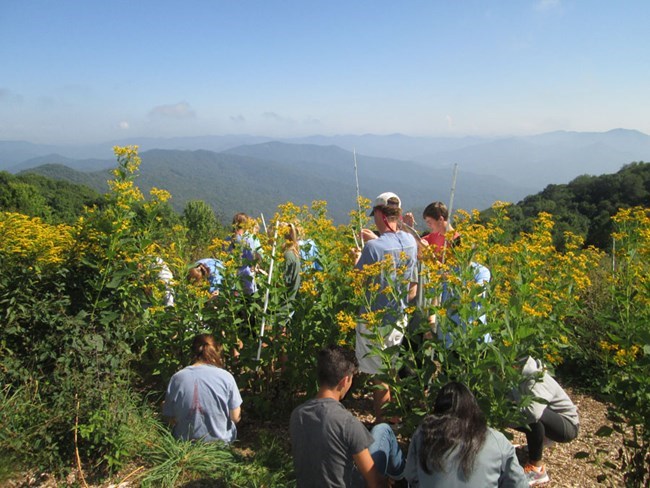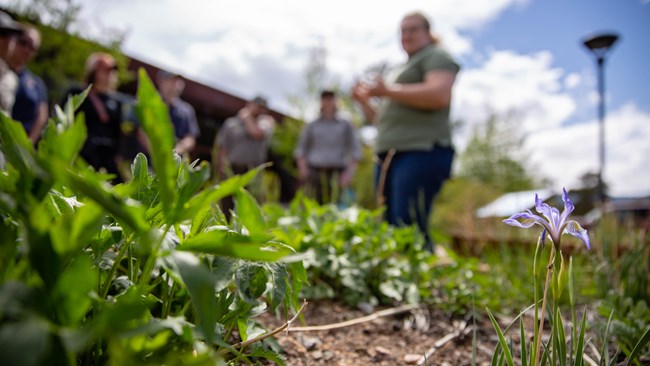Can you look at plants in a garden to learn if the air you breathe is clean? Students and teachers have been doing just that by planting and monitoring ozone gardens in national parks around the country.

Ozone in the upper atmosphere forms a layer that absorbs the sun's harmful ultraviolet rays and protects life on Earth. At ground level, ozone is harmful to human health and the environment. Ground-level ozone forms when other pollutants, mainly nitrogen oxides and volatile organic compounds, react in the presence of sunlight. Ozone levels are generally highest during the warmer months of the year and peak during the middle to end of the day.
By carefully observing the leaves on plants in ozone gardens, these budding scientists have been tracking changing ozone levels in national parks. Just as a doctor checks your pulse, we can look at plant leaves for signs of illness from air pollution. Ozone gardens have been established at Great Smoky Mountains and Rocky Mountain National Parks.
How ozone affects plants
High concentrations of ground level ozone can damage plant tissue over time, making it harder for plants to produce and store food. Plants “breathe” (respire), through openings on the bottom of their leaves called stomata. Stomata are like tiny doors that open when the plant needs to take in air. However, once the stomata are open, they can also release things the plant needs, like water. The plant can’t control what particles come in and out of the stomata. They can only control when and how long the stomata are open. This means that pollutants, like ozone, can enter their leaves whenever the stomata are open.
Ozone can also make it more difficult for the plant to close the stomata all the way. ‘Leaky’ stomata can let water escape that the plant needs to survive. Ozone plant damage occurs when there are many consecutive days with ozone levels above about 40 to 60 parts per billion (ppb). In comparison, human health can be affected on a single day when ozone levels are 70 ppb or above. That’s why ozone sensitive plants show more damage at the end of summer than at the beginning.
- Duration:
- 20 seconds
An air quality expert describes cumulative ozone damage on plant leaves
Not all plants are sensitive to ozone pollution, but those that are will grow slower and can be less resistant to disease and insect infestation. Ozone gardens are planted with special bioindicator species that show visible signs of ozone damage on their leaves, like yellowing or black spots. Other sensitive plant species may be affected by high ozone levels, but we aren’t able to see ozone injury on their leaves. Plants that are highly sensitive to ozone are all around us — ponderosa pines, quaking aspens, red maple, cut-leaf coneflower, skunkbush, and milkweed. Over 130 ozone sensitive plant species have been identified in parks.
- Duration:
- 15 seconds
A National Park Service expert explains how plants can be used to monitor the effects of ozone damage on vegetation.

Robin Rohrback, Adapted by American Geosciences Institute
What does ozone damage look like?
Plant leaves can be damaged by frost, insects, or fungus but ozone damage has some characteristic clues that you can look for. Ozone injury starts out as just a few angular spots or “stipples.” These stipples are only visible on top of the leaf. The undersides of leaves remain free of visible injury. In addition, ozone injury does not appear on leaf veins or veinlets. Older leaves at the base of plants show more injury because they have been exposed to ozone the longest.
- Duration:
- 26 seconds
A National Park Service expert explains how to recognize ozone damage on plants in an ozone garden
Why use gardens?
Planting ozone gardens increases opportunities for citizen scientists and park staff to observe and document plant responses to ozone over the course of a growing season. Planting multiple sensitive species that may not usually grow near one another in one place allows park managers to understand parkwide responses to ozone pollution. It also gives visitors the opportunity to see bioindicators of current air quality. When visitors can interact with data collection, they are more likely to connect human action and environmental response.

Photo courtesy of Mackenzie Reed/NPS.
Well designed ozone gardens include:
-
Ozone sensitive plants that are native to the area
-
A location that receives the amount of sunlight needed for ozone sensitive plants
- Access to water and a plan to keep the garden watered once or twice a week in drier climates
Note, gardens located near heavy traffic, parking lots, or other pollution sources may have more ozone than locations that are behind belts of trees or open green spaces.
How to monitor
Monitoring for ozone damage to sensitive plants in a garden can be irregular and informal or quite structured. Informal monitoring may consist of periodic observations, photographs, and notes. More formal monitoring will record the percentage of ozone damage on the leaf surface from a set number of plants and leaves regularly during the growing season.
Last updated: August 11, 2025
